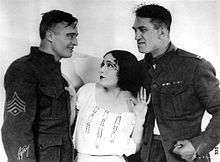What Price Glory? (1926 film)
| What Price Glory? | |
|---|---|
 German language release poster | |
| Directed by | Raoul Walsh |
| Produced by | William Fox |
| Written by |
James T. O'Donohoe (scenario) Malcolm Stuart Boylan (intertitles) |
| Based on |
What Price Glory? by Maxwell Anderson and Laurence Stallings |
| Starring |
Victor McLaglen Edmund Lowe Dolores del Río Phyllis Haver |
| Music by |
Ernö Rapée Lew Pollack |
| Cinematography |
Barney McGill John Marta John Smith |
| Distributed by | Fox Film Corporation |
Release dates |
|
Running time | 116 mins. |
| Country | United States |
| Language | Silent |
| Box office | $2 million[1] |
What Price Glory is a 1926 American silent comedy-drama war film produced and distributed by Fox Film Corporation and directed by Raoul Walsh. The film is based on the 1924 play What Price Glory by Maxwell Anderson and Laurence Stallings and was remade in 1952 as What Price Glory starring James Cagney.[2][3] Malcolm Stuart Boylan, founder of the U.S. Coast Guard Auxiliary, was title writer on the silent Fox attraction.[4]
Plot
Flagg and Quirt are veteran United States Marines sergeants whose rivalry dates back a number of years. Flagg is commissioned a Captain, he is in command of a company on the front lines of France during World War I. Sergeant Quirt is assigned to Flagg's unit as the senior non-commissioned officer. Flagg and Quirt quickly resume their rivalry, which this time takes its form over the affections of Charmaine, the daughter of the local innkeeper. However, Charmaine's desire for a husband and the reality of war give the two men a common cause.
Cast
- Edmund Lowe as 1st Sergeant Quirt
- Victor McLaglen as Captain Flagg
- Dolores del Río as Charmaine de la Cognac
- William V. Mong as Cognac Pete
- Phyllis Haver as Shanghai Mabel
- Elena Jurado as Carmen, Philippine girl
- Leslie Fenton as Lieutenant Moore
- Barry Norton as Private 'Mother's Boy' Lewisohn
- Sammy Cohen as Private Lipinsky
- Ted McNamara as Private Kiper
- August Tollaire as French Mayor
- Mathilde Comont as Camille, fat lady
- Patrick Rooney as Mulcahy (billed as Pat Rooney)
- J. Carrol Naish bit part
Production

The film was directed by Raoul Walsh and released as a silent film by Fox Film Corporation on November 23, 1926 in the US, and had a 116-minute running time. On January 21, 1927, a short film of singer Raquel Meller was shown before this feature at the Sam H. Harris Theater in New York City. The short film, not quite synchronized, was the first public presentation of a film in the Fox Movietone sound-on-film system.[5] In January 1927, Fox re-released What Price Glory? with synchronized sound effects and music in the Movietone system.[6]
Part of its fame revolves around the fact that the characters can be seen speaking profanities which are not reflected in the intertitles, but which can be deciphered by lipreaders. The studio was reportedly inundated by calls and letters from enraged Americans, including deaf and hearing impaired people, to whom the vivid profanity between Sergeant Quirt and Captain Flagg was extremely offensive.
In the 1924 Broadway play the roles of Captain Flagg and Sgt. Quirt were played by Louis Wolheim, fresh from his triumph in Eugene O'Neill's The Hairy Ape and William "Stage" Boyd. Curiously Wolheim and the younger William Boyd would play characters similar to Quirt and Flagg in the 1928 film Two Arabian Knights.
In his autobiography, Peter Cushing claimed his own wife Violet Helen Beck Cushing was part of the cast prior to their marriage.
Adaptation
McLaglen and Lowe reprised their roles from the movie in the radio program Captain Flagg and Sergeant Quirt, broadcast on the Blue Network September 28, 1941 - January 25, 1942, and on NBC February 13, 1942 - April 3, 1942.[7]
Sequels
- The Cock-Eyed World (1928) (directed by Raoul Walsh)
- Women of All Nations (1931) (directed by Raoul Walsh)
- The Stolen Jools (1931) (cameo)
- Hot Pepper (1933)
Lowe and McLaglen played two similar Marines in the RKO Radio Pictures film Call Out the Marines (1942).
References
- ↑ "WHICH CINEMA FILMS HAVE EARNED THE MOST MONEY SINCE 1914?.". The Argus (Melbourne, Vic. : 1848 - 1956). Melbourne, Vic.: National Library of Australia. 4 March 1944. p. 3 Supplement: The Argus Weekend magazine. Retrieved 6 August 2012.
- ↑ Arthur Gewirtz, James J. Kolb (2004). Art, Glitter, and Glitz: Mainstream Playwrights and Popular Theatre in 1920s America. Praeger/GreenwoodPlays. ISBN 0-313-32467-0.
- ↑ What Price Glory the play as produced on Broadway at the Plymouth Theatre, September 5, 1924 to September 12, 1925, 435 performances; IBDB.com database
- ↑ Staedeli, Thomas. "Porträt des Drehbuchautor Malcolm Stuart Boylan". Swiss SIlent Film Website. Cyranos2000. Retrieved 022 January 2014. Check date values in:
|access-date=(help) - ↑ Edwin M. Bradley, The First Hollywood Musicals: A Critical Filmography of 171 Features, 1927 through 1932 (McFarland, 2004) p6
- ↑ SilentEra entry
- ↑ Dunning, John. (1998). On the Air: The Encyclopedia of Old-Time Radio. Oxford University Press. ISBN 978-0-19-507678-3. Pp. 136-137.
External links
- What Price Glory? at the Internet Movie Database
- What Price Glory? at SilentEra
- What Price Glory? at AllMovie